2013 BMW 135I CONVERTIBLE tire size
[x] Cancel search: tire sizePage 96 of 284

95
Technology for driving comfort and safety
Controls
Message for unsuc
cessful system
reset
Yellow warning lamp lights up. A
message appears on the Control
Display.
The system has detected a wheel change, but
was not reset. A reliable warning is not possible
at the current inflation pressures.
Check the tire inflation pressure and reset the
system, refer to page 93.
Malfunction
The small warning lamp flashes in
yellow and then lights up continu-
ously; the large warning lamp lights
up in yellow. The tires appear in gray
in the Control Display. No punctures can be
detected.
Display in the following situations:
> A wheel without TPM electronics has been
installed:
Have it checked by your BMW center.
> Malfunction
Have the system checked
> Tire Pressure Monitor was unable to
complete the resetting process. Reset the
system again.
The small warning lamp flashes in
yellow and then lights up continu-
ously; the large warning lamp lights
up in yellow. The tires appear in gray
in the Control Display.
Display in the following situations:
Interference from systems or devices that use
the same radio frequency. The system auto-
matically becomes active again when the vehi-
cle moves out of the interference zone.
Declaration according to NHTSA/
FMVSS 138
Tire Pressure Monitoring Systems
Each tire should be checked monthly when cold
and inflated to the inflation pressure recom-
mended by the vehicle manufacturer on the vehicle placard or tire infl
ation pressure label. If
your vehicle has tires of a different size than the
size indicated on the vehi cle placard or tire infla-
tion pressure label, you should determine the
proper tire inflation pressure for those tires. As
an added safety feature, your vehicle has been
equipped with a tire pr essure monitoring sys-
tem, TPMS, that illuminate s a low tire pressure
t e l l t a l e w h e n o n e o r m o r e o f y o u r t i r e s a r e s i g n i f -
icantly underinflated. Accordingly, when the
low tire pressure telltal e illuminates, you should
stop and check your tires as soon as possible,
and inflate them to the proper pressure. Driving
on a significantly underinflated tire causes the
tire to overheat and ca n lead to tire failure.
Underinflation also reduces fuel efficiency and
tire tread life and may a ffect the vehicle's han-
dling and stopping ability. Please note that the
TPMS is not a substitute for proper tire mainte-
nance, and it is the driver's responsibility to
maintain correct tire pr essure, even if underin-
flation has not reached th e level to trigger illumi-
nation of the TPMS low tire pressure indicator.
The TPMS malfunction indicator is combined
with the low tire pressure telltale. When the sys-
tem detects a malfunction, the telltale will flash
for approximately one minute and then remain
continuously lit. This sequence will continue
upon subsequent vehicle startups as long as
the malfunction exists. When the malfunction
indicator is illuminated, the system may not be
able to detect or signal low tire pressure as
intended. TPMS malfunctions may occur for a
variety of reasons, includ ing the installation of
replacement or alternate tires or wheels on the
vehicle that prevent the TPMS from functioning
properly. Always check the TPMS malfunction
telltale after replacing one or more tires or
wheels on your vehicle to ensure that the
replacement or alternate tires and wheels allow
the TPMS to continue to function properly.
00320051004F004C00510048000300280047004C0057004C005200510003
Page 99 of 284
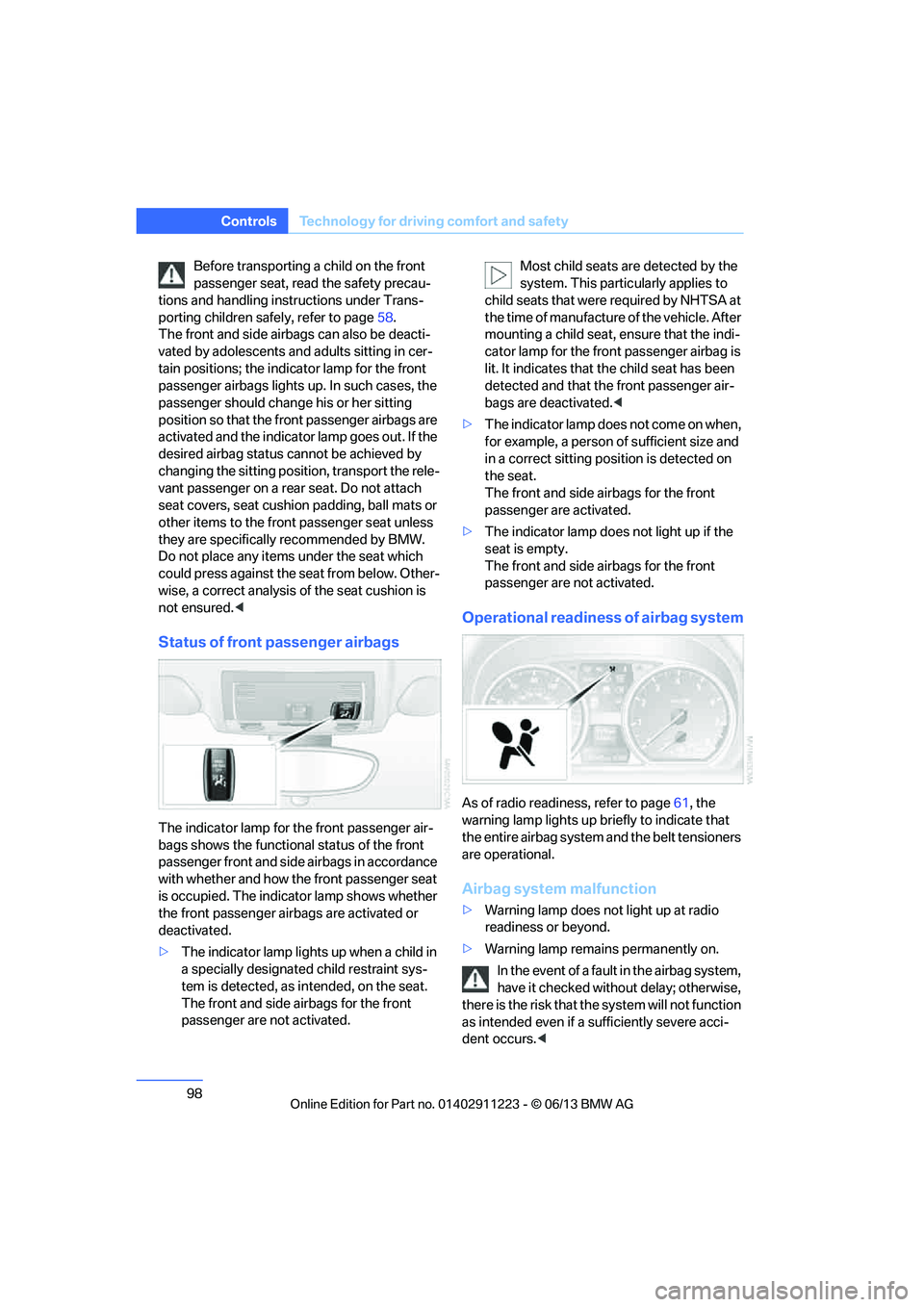
98
ControlsTechnology for driving comfort and safety
Before transporting a child on the front
passenger seat, read the safety precau-
tions and handling inst ructions under Trans-
porting children safely, refer to page 58.
The front and side airbags can also be deacti-
vated by adolescents and adults sitting in cer-
tain positions; the indi cator lamp for the front
passenger airbags lights up. In such cases, the
passenger should change his or her sitting
position so that the fr ont passenger airbags are
activated and the indicator lamp goes out. If the
desired airbag status cannot be achieved by
changing the sitting position, transport the rele-
vant passenger on a rear seat. Do not attach
seat covers, seat cushion padding, ball mats or
other items to the front passenger seat unless
they are specifically recommended by BMW.
Do not place any items under the seat which
could press against the seat from below. Other-
wise, a correct analysis of the seat cushion is
not ensured. <
Status of front passenger airbags
The indicator lamp for the front passenger air-
bags shows the functional status of the front
passenger front and side airbags in accordance
with whether and how the front passenger seat
is occupied. The indicator lamp shows whether
the front passenger airbags are activated or
deactivated.
>The indicator lamp lights up when a child in
a specially designated child restraint sys-
tem is detected, as in tended, on the seat.
The front and side airbags for the front
passenger are not activated. Most child seats are detected by the
system. This partic
ularly applies to
child seats that were required by NHTSA at
the time of manufacture of the vehicle. After
mounting a child seat, ensure that the indi-
cator lamp for the fron t passenger airbag is
lit. It indicates that th e child seat has been
detected and that the front passenger air-
bags are deactivated. <
> The indicator lamp does n o t c o m e o n w h e n ,
for example, a person of sufficient size and
in a correct sitting position is detected on
the seat.
The front and side airbags for the front
passenger are activated.
> The indicator lamp does not light up if the
seat is empty.
The front and side airbags for the front
passenger are not activated.
Operational readine ss of airbag system
As of radio readiness, refer to page 61, the
warning lamp lights up br iefly to indicate that
the entire airbag system and the belt tensioners
are operational.
Airbag system malfunction
> Warning lamp does not light up at radio
readiness or beyond.
> Warning lamp remains permanently on.
In the event of a fault in the airbag system,
have it checked withou t delay; otherwise,
there is the risk that th e system will not function
as intended even if a sufficiently severe acci-
dent occurs. <
00320051004F004C00510048000300280047004C0057004C005200510003
Page 224 of 284
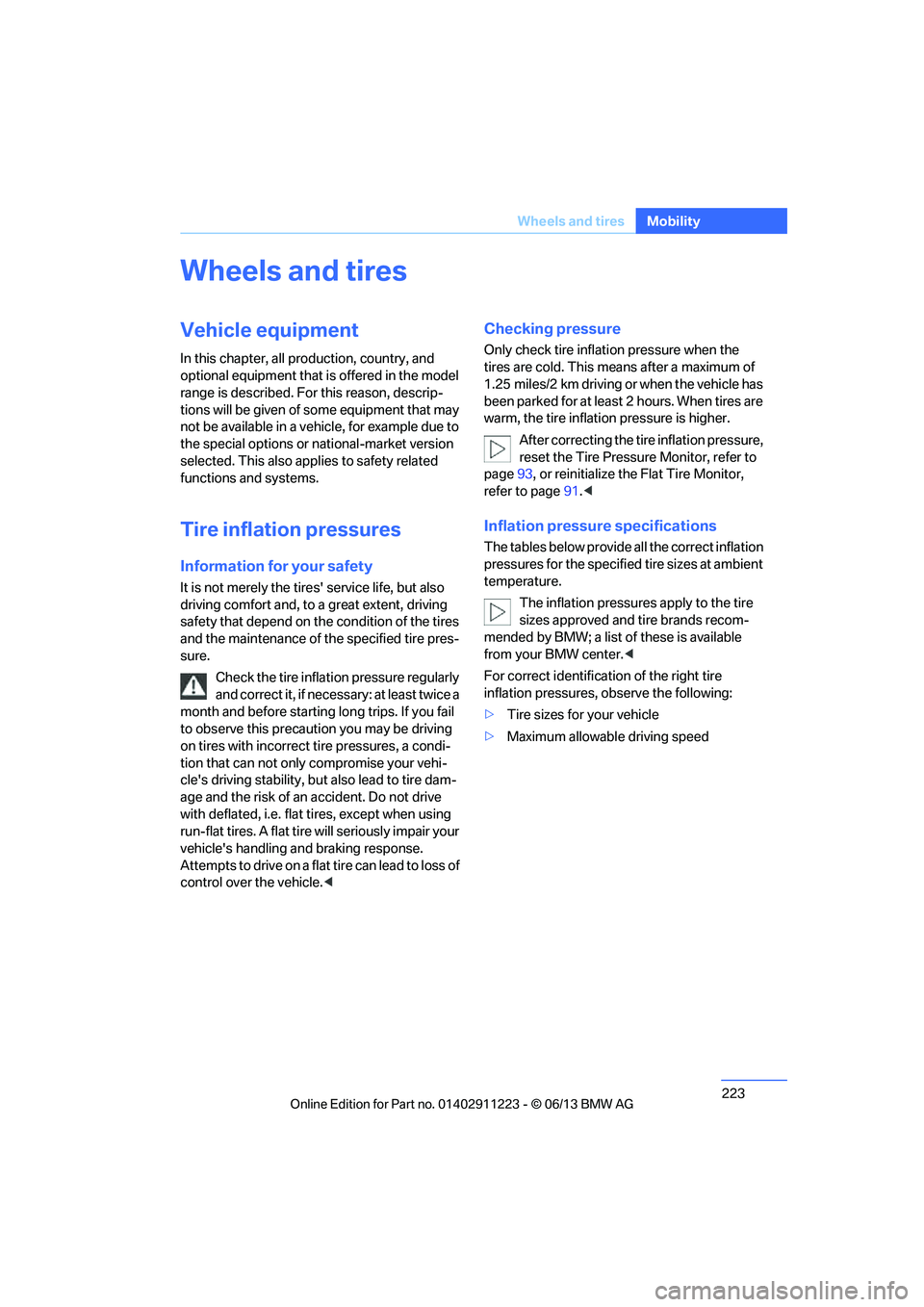
223
Wheels and tires
Mobility
Wheels and tires
Vehicle equipment
In this chapter, all production, country, and
optional equipment that is offered in the model
range is described. For this reason, descrip-
tions will be given of some equipment that may
not be available in a vehi
cle, for example due to
the special options or national-market version
selected. This also app lies to safety related
functions and systems.
Tire inflation pressures
Information for your safety
It is not merely the tire s' service life, but also
driving comfort and, to a great extent, driving
safety that depend on th e condition of the tires
and the maintenance of th e specified tire pres-
sure.
Check the tire inflation pressure regularly
and correct it, if nece ssary: at least twice a
month and before starting long trips. If you fail
to observe this precaution you may be driving
on tires with incorrect tire pressures, a condi-
tion that can not only compromise your vehi-
cle's driving stability, but also lead to tire dam-
age and the risk of an accident. Do not drive
with deflated, i.e. flat tires, except when using
run-flat tires. A flat tire will seriously impair your
vehicle's handling and braking response.
Attempts to drive on a flat tire can lead to loss of
control over the vehicle. <
Checking pressure
Only check tire inflation pressure when the
tires are cold. This means after a maximum of
1.25 miles/2 km driving or when the vehicle has
been parked for at least 2 hours. When tires are
warm, the tire inflation pressure is higher.
After correcting the tire inflation pressure,
reset the Tire Pressure Monitor, refer to
page 93, or reinitialize the Flat Tire Monitor,
refer to page 91.<
Inflation pressure specifications
The tables below provide all the correct inflation
pressures for the specified tire sizes at ambient
temperature.
The inflation pressure s apply to the tire
sizes approved and tire brands recom-
mended by BMW; a list of these is available
from your BMW center. <
For correct identificati on of the right tire
inflation pressures, observe the following:
> Tire sizes for your vehicle
> Maximum allowable driving speed
00320051004F004C00510048000300280047004C0057004C005200510003
Page 226 of 284
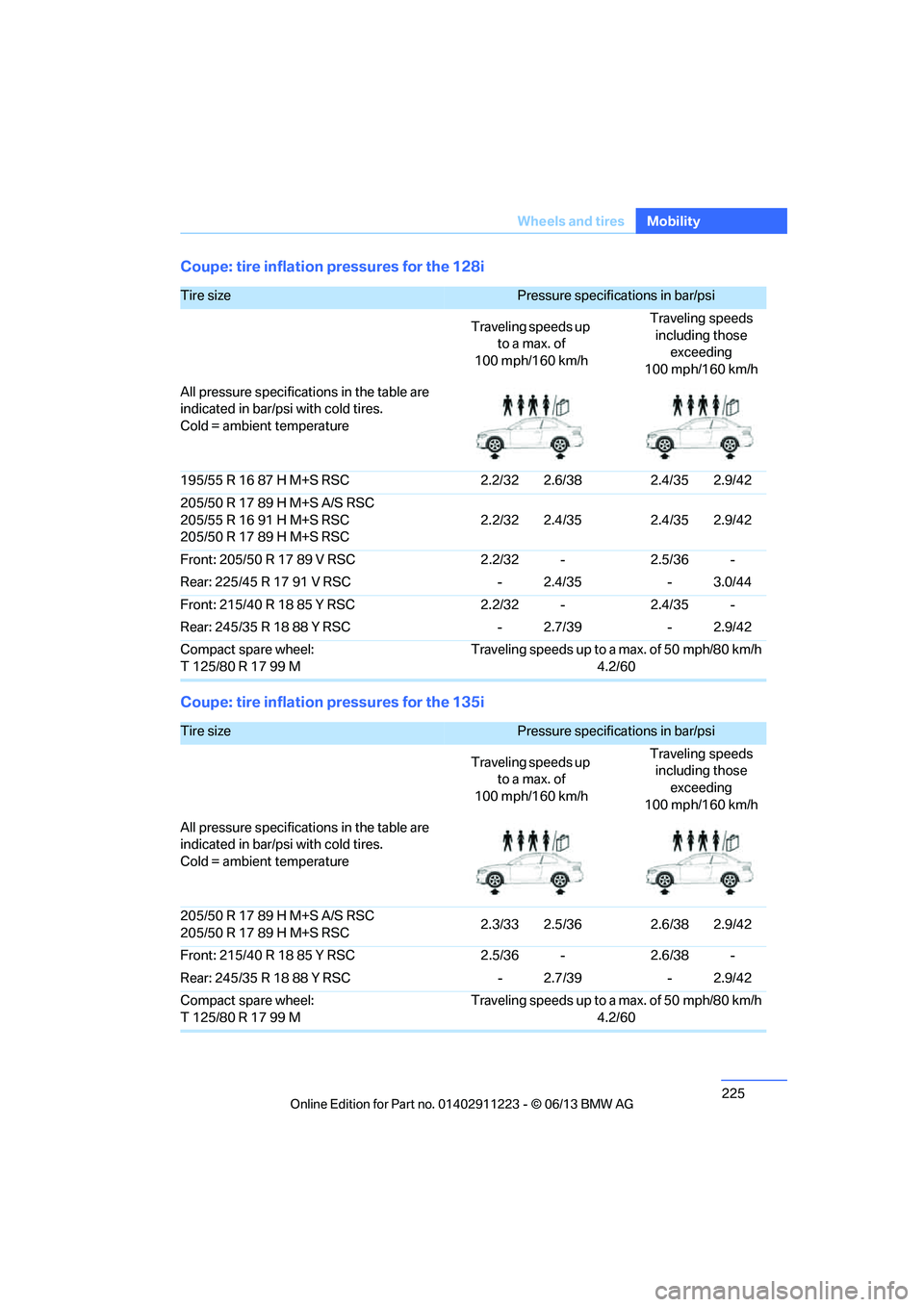
225
Wheels and tires
Mobility
Coupe: tire inflation pressures for the 128i
Coupe: tire inflation pressures for the 135i
Tire size Pressure specifications in bar/psi
Traveling speeds up to a max. of
100 mph/160 km/h Traveling speeds
including those exceeding
100 mph/160 km/h
All pressure specifications in the table are
indicated in bar/psi with cold tires.
Cold = ambient temperature
195/55 R 16 87 H M+S RSC 2.2/32 2.6/38 2.4/35 2.9/42
205/50 R 17 89 H M+S A/S RSC
205/55 R 16 91 H M+S RSC
205/50 R 17 89 H M+S RSC 2.2/32 2.4/35 2.4/35 2.9/42
Front: 205/50 R 17 89 V RSC 2.2/32 - 2.5/36 -
Rear: 225/45 R 17 91 V RSC - 2.4/35 - 3.0/44
Front: 215/40 R 18 85 Y RSC 2.2/32 - 2.4/35 -
Rear: 245/35 R 18 88 Y RSC - 2.7/39 - 2.9/42
Compact spare wheel:
T 125/80 R 17 99 M Traveling speeds up to a max. of 50 mph/80 km/h
4.2/60
Tire size Pressure specifications in bar/psi
Traveling speeds up to a max. of
100 mph/160 km/h Traveling speeds
including those
exceeding
100 mph/160 km/h
All pressure specifications in the table are
indicated in bar/psi with cold tires.
Cold = ambient temperature
205/50 R 17 89 H M+S A/S RSC
205/50 R 17 89 H M+S RSC 2.3/33 2.5/36
2.6/38 2.9/42
Front: 215/40 R 18 85 Y RSC 2.5/36 -2.6/38 -
Rear: 245/35 R 18 88 Y RSC - 2.7/39- 2.9/42
Compact spare wheel:
T 125/80 R 17 99 M Traveling speeds up to a max. of 50 mph/80 km/h
4.2/60
00320051004F004C00510048000300280047004C0057004C005200510003
Page 227 of 284
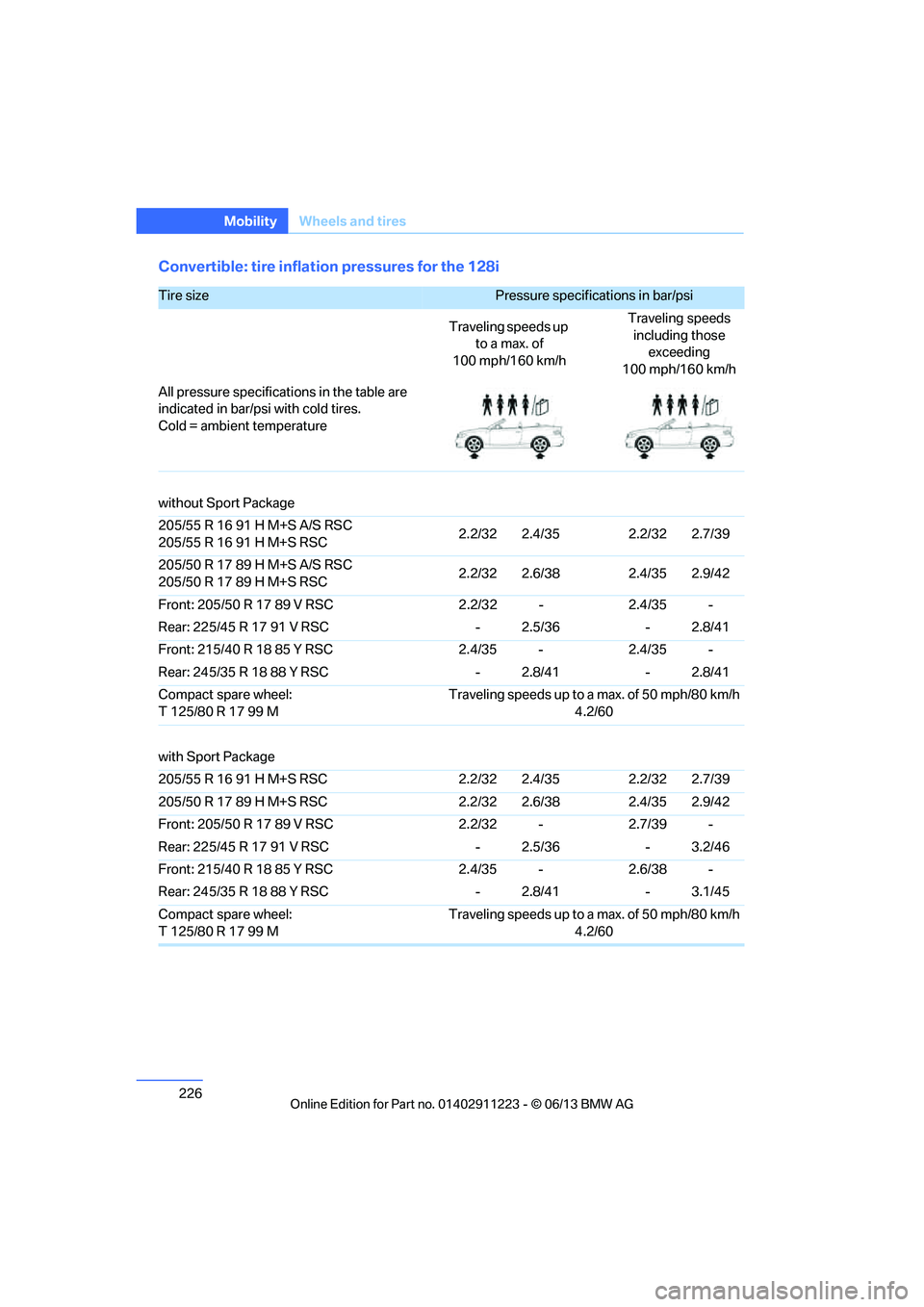
226
MobilityWheels and tires
Convertible: tire inflation pressures for the 128i
Tire size Pressure specifications in bar/psi
Traveling speeds up to a max. of
100 mph/160 km/h Traveling speeds
including those exceeding
100 mph/160 km/h
All pressure specificat ions in the table are
indicated in bar/psi with cold tires.
Cold = ambient temperature
without Sport Package
205/55 R 16 91 H M+S A/S RSC
205/55 R 16 91 H M+S RSC 2.2/32 2.4/35 2.2/32 2.7/39
205/50 R 17 89 H M+S A/S RSC
205/50 R 17 89 H M+S RSC 2.2/32 2.6/38 2.4/35 2.9/42
Front: 205/50 R 17 89 V RSC 2.2/32 - 2.4/35 -
Rear: 225/45 R 17 91 V RSC - 2.5/36 - 2.8/41
Front: 215/40 R 18 85 Y RSC 2.4/35 - 2.4/35 -
Rear: 245/35 R 18 88 Y RSC - 2.8/41 - 2.8/41
Compact spare wheel:
T 125/80 R 17 99 M Traveling speeds up to a max. of 50 mph/80 km/h
4.2/60
with Sport Package
205/55 R 16 91 H M+S RSC 2.2/32 2.4/35 2.2/32 2.7/39
205/50 R 17 89 H M+S RSC 2.2/32 2.6/38 2.4/35 2.9/42
Front: 205/50 R 17 89 V RSC 2.2/32 - 2.7/39 -
Rear: 225/45 R 17 91 V RSC - 2.5/36 - 3.2/46
Front: 215/40 R 18 85 Y RSC 2.4/35 - 2.6/38 -
Rear: 245/35 R 18 88 Y RSC - 2.8/41 - 3.1/45
Compact spare wheel:
T 125/80 R 17 99 M Traveling speeds up to a max. of 50 mph/80 km/h
4.2/60
00320051004F004C00510048000300280047004C0057004C005200510003
Page 228 of 284
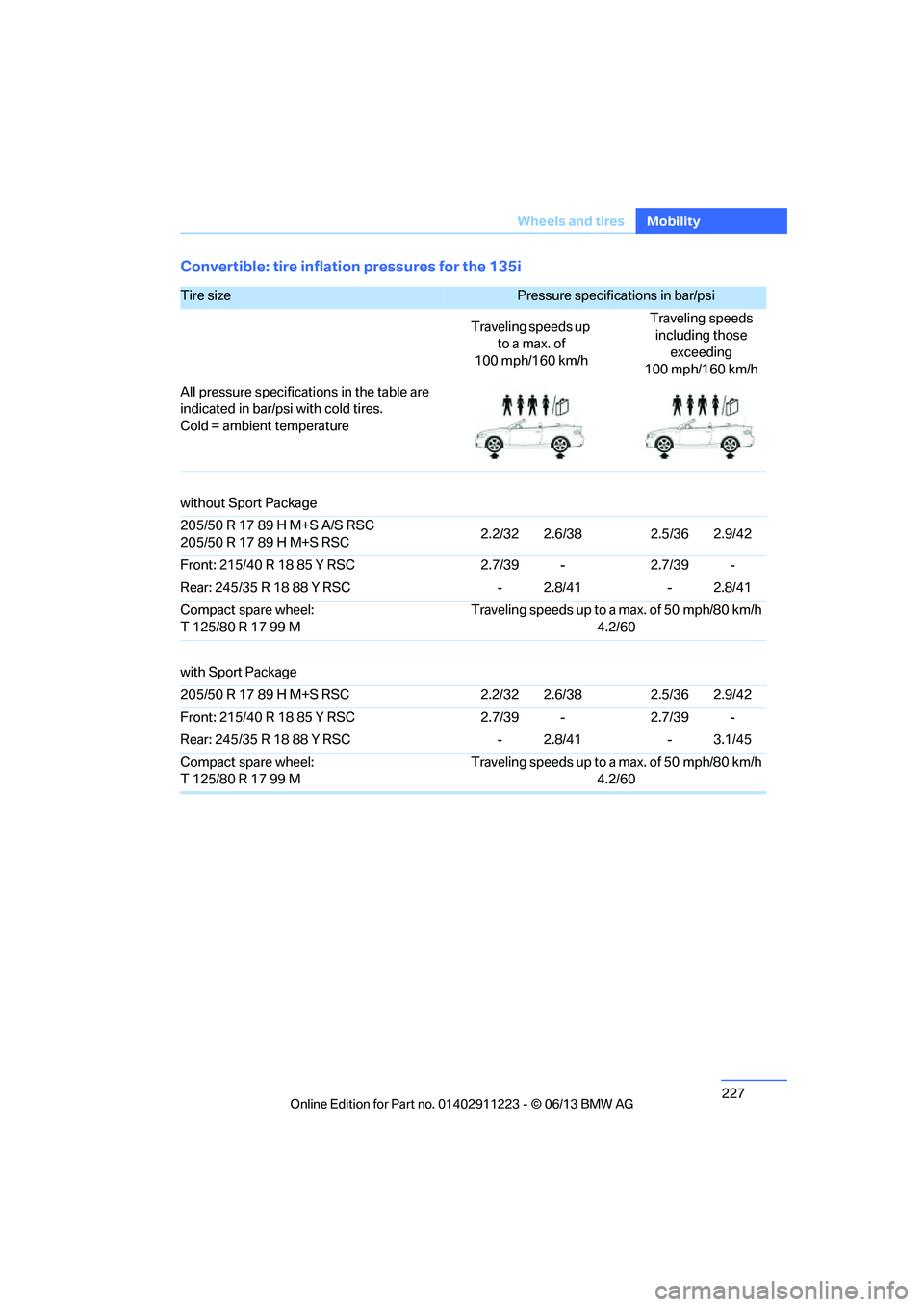
227
Wheels and tires
Mobility
Convertible: tire inflation pressures for the 135i
Tire size Pressure specifications in bar/psi
Traveling speeds up to a max. of
100 mph/160 km/h Traveling speeds
including those exceeding
100 mph/160 km/h
All pressure specifications in the table are
indicated in bar/psi with cold tires.
Cold = ambient temperature
without Sport Package
205/50 R 17 89 H M+S A/S RSC
205/50 R 17 89 H M+S RSC 2.2/32 2.6/38 2.5/36 2.9/42
Front: 215/40 R 18 85 Y RSC 2.7/39 - 2.7/39 -
Rear: 245/35 R 18 88 Y RSC - 2.8/41 - 2.8/41
Compact spare wheel:
T 125/80 R 17 99 M Traveling speeds up to a max. of 50 mph/80 km/h
4.2/60
with Sport Package
205/50 R 17 89 H M+S RSC 2.2/32 2.6/38 2.5/36 2.9/42
Front: 215/40 R 18 85 Y RSC 2.7/39 - 2.7/39 -
Rear: 245/35 R 18 88 Y RSC - 2.8/41 - 3.1/45
Compact spare wheel:
T 125/80 R 17 99 M Traveling speeds up to a max. of 50 mph/80 km/h
4.2/60
00320051004F004C00510048000300280047004C0057004C005200510003
Page 229 of 284
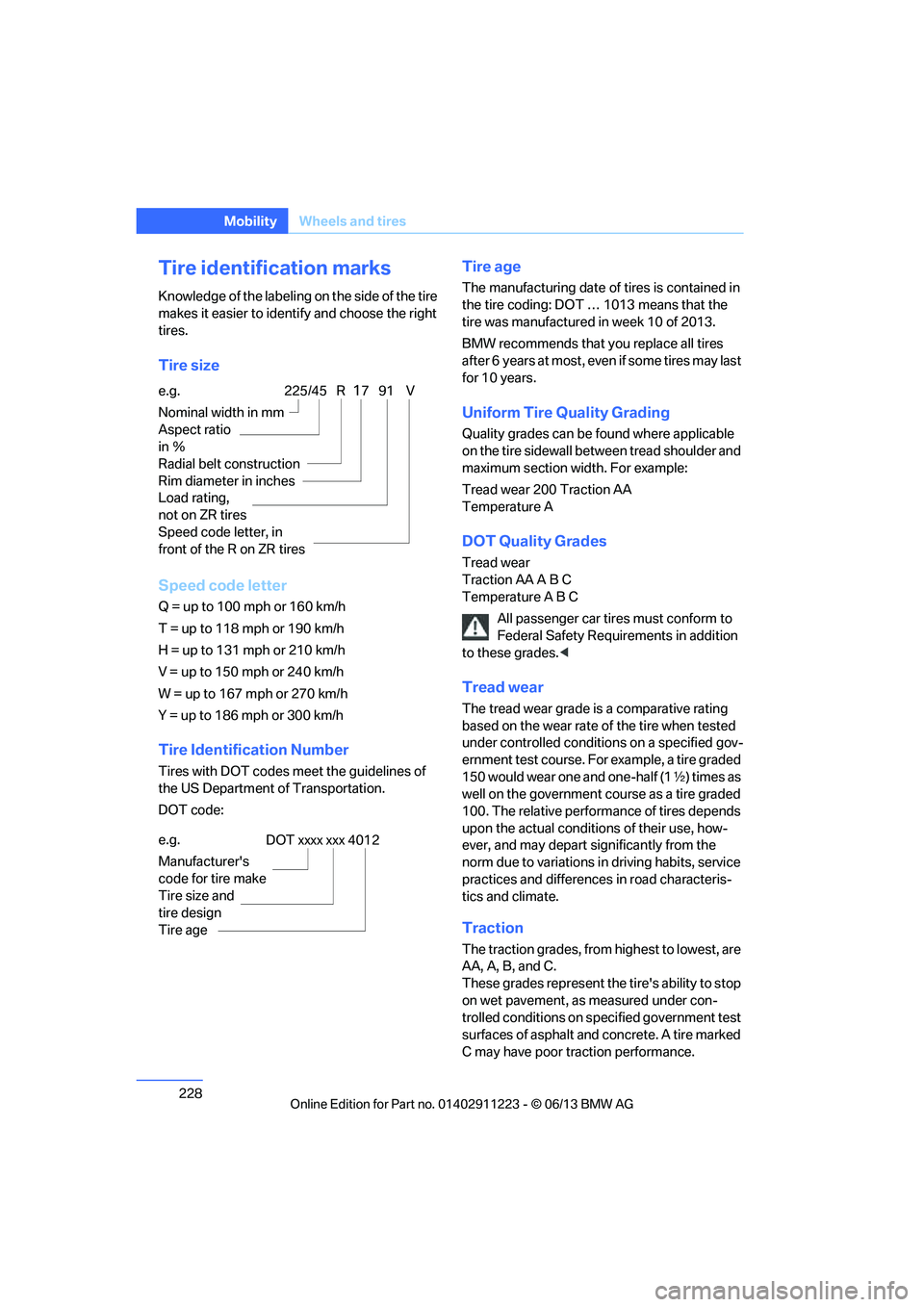
228
MobilityWheels and tires
Tire identification marks
Knowledge of the labeling on the side of the tire
makes it easier to identify and choose the right
tires.
Tire size
Speed code letter
Q = up to 100 mph or 160 km/h
T = up to 118 mph or 190 km/h
H = up to 131 mph or 210 km/h
V = up to 150 mph or 240 km/h
W = up to 167 mph or 270 km/h
Y = up to 186 mph or 300 km/h
Tire Identification Number
Tires with DOT codes meet the guidelines of
the US Department of Transportation.
DOT code:
Tire age
The manufacturing date of tires is contained in
the tire coding: DOT … 1013 means that the
tire was manufactured in week 10 of 2013.
BMW recommends that you replace all tires
after 6 years at most, even if some tires may last
for 10 years.
Uniform Tire Quality Grading
Quality grades can be found where applicable
on the tire sidewall betw een tread shoulder and
maximum section width. For example:
Tread wear 200 Traction AA
Temperature A
DOT Quality Grades
Tread wear
Traction AA A B C
Temperature A B C
All passenger car tires must conform to
Federal Safety Requir ements in addition
to these grades. <
Tread wear
The tread wear grade is a comparative rating
based on the wear rate of the tire when tested
under controlled conditio ns on a specified gov-
ernment test course. For example, a tire graded
150 would wear one and one-half (1 γ) times as
well on the government course as a tire graded
100. The relative performance of tires depends
upon the actual conditio ns of their use, how-
ever, and may depart significantly from the
norm due to variations in driving habits, service
practices and differences in road characteris-
tics and climate.
Traction
The traction grades, from highest to lowest, are
AA, A, B, and C.
These grades represent the tire's ability to stop
on wet pavement, as measured under con-
trolled conditions on specified government test
surfaces of asphalt and concrete. A tire marked
C may have poor traction performance.
e.g.
Nominal width in mm
Aspect ratio
in
Ξ
Radial belt construction
Rim diameter in inches
Load rating,
not on ZR tires
Speed code letter, in
front of the R on ZR tires
225/45 R1791 V
e.g.
Manufacturer's
code for tire make
Tire size and
tire design
Tire ageDOT xxxx xxx 4012
00320051004F004C00510048000300280047004C0057004C005200510003
Page 231 of 284

230
MobilityWheels and tires
Unusual vibrations encountered during normal
vehicle operation can indicate tire failure or
some other vehicle defect. This can, for exam-
ple, be caused by driving over curbs. The same
applies to any other abnormal road behavior,
such as pulling severely to the right or left.
In these cases, reduce speed immedi-
ately and have wheels and tires thor-
oughly checked. To do so , drive carefully to the
nearest BMW center or tire dealer. If necessary,
have the vehicle towed there.
O t h e r w i s e , t i r e d a m a g e c a n p o s e a l e t h a l h a z a r d
to vehicle occupants and other road users. <
Tire age
For various reasons, such as the development
of brittleness, BMW recommends tire replace-
ment after no more than 6 years, regardless of
the actual wear of the tires.
The manufacturing date of tires is contained in
the tire coding:
DOT ... 1013 means that the tire was manufac-
tured in week 10 of 2013.
New wheels and tires
Have new wheels and tires mounted only
by your BMW center or by a tire dealer. If
this work is not carried out properly, there is a
danger of subsequent damage and related
safety hazards. Make sure that the new wheels
are balanced. <
Retreaded tires
BMW recommends that you do not use
retreaded tires, since driving safety may
be impaired. The causes for this include poten-
tially different tire casing structures and often
wide variations in tire ag e, which can result in a
limited service life. <
Correct wheels and tires
When mounting new tires or changing over
from summer to winter tires and vice versa,
mount run-flat tires for your own safety. In the
event of a flat, no spare wheel is available. Your
BMW center will be glad to advise you.
BMW recommends that you use only
wheel and tire combinations that BMW
has tested and approved for your particular
vehicle. Variations in factors such as manufac-
turing tolerances mean that even wheels and
tires with identical offi cial size ratings could
actually have different dimensions, which could
lead to body contact an d thus to severe acci-
dents. If non-approved wheels and tires are
used, BMW cannot evaluate their suitability,
and therefore cannot guarantee their driving
safety. <
You can inquire about the right wheel/tire
combination at your BMW center.
The correct combination of wheels and tires is
also necessary to ensure reliable operation of
various vehicle systems such as ABS, DSC or
FTM.
To maintain good handling and vehicle
response, use only tires of a single brand and
tread configuration. Af ter a tire has been
damaged, mount the previous wheel and tire
combination again as soon as possible.
Wheels with Tire Pressure Monitor
TPM electronics
When mounting new tires or changing over
from summer to winter tires, or vice versa, only
use wheels with TPM electronics; otherwise,
the Tire Pressure Monito r may not be able to
detect a puncture, refer to page 94. Your BMW
center will be glad to advise you.
00320051004F004C00510048000300280047004C0057004C005200510003